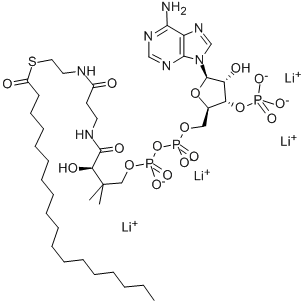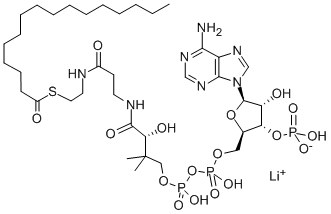ACETYL COENZYME A TRILITHIUM SALT
Synonym(s):Acetyl-CoA;Acetylcoenzyme A, Trilithium Salt - CAS 75520-41-1 - Calbiochem;Acetyl-S-CoA Li3
- CAS NO.:75520-41-1
- Empirical Formula: C23H39LiN7O17P3S
- Molecular Weight: 817.52
- MDL number: MFCD00167406
- EINECS: 278-233-4
- SAFETY DATA SHEET (SDS)
- Update Date: 2023-04-23 13:52:06

What is ACETYL COENZYME A TRILITHIUM SALT?
Description
Acetyl-CoA (75520-41-1) is an essential cofactor for cellular metabolism, being an ‘activated acetate’ that shuttles its moieties back and forth during anabolic, catabolic, and metabolic processes involving fundamental molecules: fatty acids, amino acids, glucose, and ATP.1 In the laboratory, it can be used as a substrate in chloramphenicol acetyltransferase (CAT) transcription reporter assays2 or in histone acetyltransferase (HAT) assays in epigenetics research3.
Chemical properties
White amorphous powder
The Uses of ACETYL COENZYME A TRILITHIUM SALT
Acetyl Coenzyme?A Lithium Salt is an important molecule in enzymatic acetyl transfer reactions. It is the source of the phosphopantetheine group that is added as a prosthetic group to acyl carrier proteins and formyltetrahydrofolate dehydrogenase.
What are the applications of Application
Acetyl Coenzyme A Trilithium Salt Trihydrate is an essential cofactor
References
Wolfe (2005), The acetate switch; Mol. Biol. Rev. 69 12 Gorman et al. (1982), Recombinant genomes which express chloramphenicol acetyltransferase in mammalian cells; Mol. Cell Biol. 2 1044 Kim et al. (2000), A continuous, nonradioactive assay for histone acetyltransferases; Anal. Biochem. 280 308
Properties of ACETYL COENZYME A TRILITHIUM SALT
| storage temp. | −20°C |
| solubility | Soluble in water (10 mg/ml) |
| form | solid |
| color | White |
| Stability: | Stable for 2 years as supplied. Solutions in water may be stored at -20°C for up to 2 weeks. |
Safety information for ACETYL COENZYME A TRILITHIUM SALT
| Signal word | Warning |
| Pictogram(s) |
 Exclamation Mark Irritant GHS07 |
| GHS Hazard Statements |
H315:Skin corrosion/irritation H319:Serious eye damage/eye irritation H335:Specific target organ toxicity, single exposure;Respiratory tract irritation |
| Precautionary Statement Codes |
P261:Avoid breathing dust/fume/gas/mist/vapours/spray. P280:Wear protective gloves/protective clothing/eye protection/face protection. |
Computed Descriptors for ACETYL COENZYME A TRILITHIUM SALT
New Products
(S)-3-Aminobutanenitrile hydrochloride 4-Methylphenylacetic acid N-Boc-D-alaninol N-BOC-D/L-ALANINOL Tert-butyl bis(2-chloroethyl)carbamate 3-Morpholino-1-(4-nitrophenyl)-5,6-dihydropyridin- 2(1H)-one Furan-2,5-Dicarboxylic Acid Tropic acid 1-Bromo-3,5-Di-Tert-Butylbenzene S-2-CHLORO PROPIONIC ACID ETHYL ISOCYANOACETATE 2-Bromo-1,3-Bis(Dimethylamino)Trimethinium Hexafluorophosphate 4-IODO BENZOIC ACID 3-NITRO-2-METHYL ANILINE 1-(2,4-DICHLOROPHENYL) ETHANAMINE (2-Hydroxyphenyl)acetonitrile 4-Bromopyrazole 2-(Cyanocyclohexyl)acetic acid 4-methoxy-3,5-dinitropyridine 1-(4-(aminomethyl)benzyl)urea hydrochloride 2-aminopropyl benzoate hydrochloride diethyl 2-(2-((tertbutoxycarbonyl)amino) ethyl)malonate tert-butyl 4- (ureidomethyl)benzylcarbamate Ethyl-2-chloro((4-methoxyphenyl)hydrazono)acetateRelated products of tetrahydrofuran








You may like
-
 Acetyl Coenzyme A Trilithium Salt CAS 75520-41-1View Details
Acetyl Coenzyme A Trilithium Salt CAS 75520-41-1View Details
75520-41-1 -
 Acetylcoenzyme A, Trilithium Salt CAS 75520-41-1View Details
Acetylcoenzyme A, Trilithium Salt CAS 75520-41-1View Details
75520-41-1 -
 1975-50-4 98%View Details
1975-50-4 98%View Details
1975-50-4 -
 2-HYDROXY BENZYL ALCOHOL 98%View Details
2-HYDROXY BENZYL ALCOHOL 98%View Details
90-01-7 -
 2-Chloro-1,3-Bis(Dimethylamino)Trimethinium Hexafluorophosphate 221615-75-4 98%View Details
2-Chloro-1,3-Bis(Dimethylamino)Trimethinium Hexafluorophosphate 221615-75-4 98%View Details
221615-75-4 -
 61397-56-6 CIS BROMO BENZOATE 98%View Details
61397-56-6 CIS BROMO BENZOATE 98%View Details
61397-56-6 -
 14714-50-2 (2-Hydroxyphenyl)acetonitrile 98+View Details
14714-50-2 (2-Hydroxyphenyl)acetonitrile 98+View Details
14714-50-2 -
 118753-70-1 98+View Details
118753-70-1 98+View Details
118753-70-1